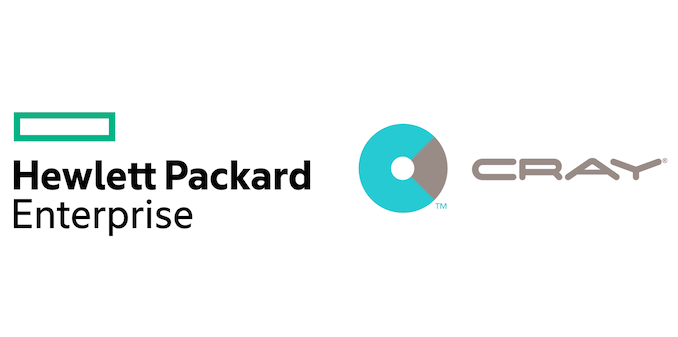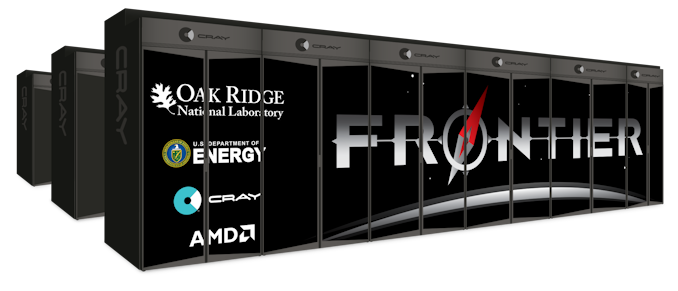Hewlett Packard Enterprise to Acquire Cray for $1.3 Billion
by Ryan Smith on May 17, 2019 9:45 AM EST- Posted in
- HPC
- Cray
- HPE
- Supercomputers

This morning Hewlett Packard Enterprise and Cray are announcing that HPE will be buying out the supercomputer maker for roughly 1.3 billion dollars. Intending to use Cray’s knowledge and technology to bolster their own supercomputing and high-performance computing technologies, when the deal closes, HPE will become the world leader for supercomputing technology.
Cray of course needs no introduction. The current leader in the supercomputing field and founder of supercomputing as we know it, Cray has been a part of the supercomputing landscape since the 1970s. Starting at the time with fully custom systems, in more recent years Cray has morphed into an integrator and scale-out specialist, combining processors from the likes of Intel, AMD, and NVIDIA into supercomputers, and applying their own software, I/O, and interconnect technologies.
The timing of the acquisition announcement closely follows other major news from Cray: the company just landed a $600 million US Department of Energy contract to supply the Frontier supercomputer to Oak Ridge National Laboratory in 2021. Frontier is one of two exascale supercomputers Cray is involved in – the other being a subcontractor for the 2021 Aurora system – and in fact Cray is involved in the only two exascale systems ordered by the US Government thus far. So in both a historical and modern context, Cray was and is one of the biggest players in the supercomputing market.
HPE for its part has some supercomputing exposure as well, however it’s nothing on the scale of what Cray has done. So for HPE, the deal represents an opportunity for the firm to acquire the know-how and technology needed to augment and evolve their own supercomputer and HPC technologies. Among other things, this deal means HPE will be picking up Cray’s Shasta system architecture as well as their new Slingshot interconnect, both of which will be core parts of Frontier.
The company sounds especially interested in incorporating these technologies into their current HPC plans. While supercomputers attract a lot of attention for obvious reasons, somewhat smaller systems are sold in much higher numbers due to costs and computing needs. Like many other hardware vendors, HPE is riding the wave of big data, including AI-driven analytics, and the company intends to grow their capabilities here using Cray’s technology. Interestingly, Cray is actually the second supercomputer manufacturer picked up by HPE over its lifetime; the company also picked up the remaining assets of Silicon Graphics back in 2016.
Broadly speaking, major acquisitions and mergers in the supercomputing space are rare events. Due to their ever-increasing price tag, only a small number of world-class supercomputers are sold each year. And due to these prices the buyers are often governments, which inevitably gives supercomputer construction a nationalistic element to it. None the less, because costs are increasing – Frontier is the US’s most expensive system yet at over $500M for the system alone – there is some pressure for consolidation as fewer systems get sold and overall performance efficiency increases have been slowing down as well. It’s not too surprising then that HPE’s plans include using Cray’s technologies to improve HPE GreenLake, the company’s HPC-as-a-Service offering.
Under the terms of the deal, HPE will be paying Cray shareholders $35 in cash for each Cray share, which is a notable price premium over Cray’s average stock price over the last year. This puts the total value of the deal at nearly $1.3 billion, with HPE expecting the deal to close in the first quarter of FY2020.
Source: HPE











46 Comments
View All Comments
HStewart - Friday, May 17, 2019 - link
Cray is building two different supercomputers - one with Intel and one with AMD. They are not choosing AMD over Intel.Lord of the Bored - Saturday, May 18, 2019 - link
They are choosing AMD for the GOOD computer and Intel gets the leftovers. Put THAT in your washer's spin cycle.That choice is almost assuredly because they are contractually obligated to use more than one vendor.
Irata - Sunday, May 19, 2019 - link
They are doing so now. If you look at how appreciative OEM seem to be of diversity wrt their x86 CPU suppliers, eva does have a point.Seems like OEMs' management values short term incentive checks over a more competitive supplier market long term.
HStewart - Friday, May 17, 2019 - link
Comment like this is not called for and should be related - and totally not relative to this articleJust for information Intel Cray based commuter is based on 10nm and not the old 14nm stuff..
Korguz - Friday, May 17, 2019 - link
" Comments like this is not called for " just like most of your negative or bashing comments towards AMD....Ashinjuka - Saturday, May 18, 2019 - link
The public names are Aurora, Frontier, and the third hasn't been released yet, but we know they're really called Balthasar, Melchior, and Caspar, don't we, Asuka?azfacea - Friday, May 17, 2019 - link
This is ridiculous, when are the regulators going to wake up. not just US, where the fok are the EU regulators, Japan, Canada, China, rest of the world. Why is this being allowed.we are sitting debating whether to break up facebook. we can't even stop duopolies merging into monopolies. WTF ????
Kevin G - Friday, May 17, 2019 - link
I am curious as to what regulators will be doing. Cray is more of a system design and fabric company. This does overlap with HPE as they of course are a large system vendor but they also have several different fabrics in their portfolio. NUMAlink was inherited by their SGI acquisition and also Gen Z (which seemingly came out of the research for "The Machine").There is plenty of competition still on the platform side with companies like IBM, Dell and SuperMicro doing hardware. Rather it is the fabric side that is consolidating as Mellonix is the other giant in this space and they were absorbed by nVidia recently. The landscape is looking more and more like the available fabric will be tied to another vendor's offerings and not freely interchangeable.
(And yes, I'm ignoring Ethernet as that is too high latency or too low bandwidth or too expensive for the HCP space.)
cybort - Friday, May 17, 2019 - link
They have different business actually...Shane H - Friday, May 17, 2019 - link
I was at SC18 last year and the exhibition floor was packed with vendors. Dell, Lenovo, Penguin, SuperMicro, IBM, Atipa, Fujitsu, just to name a few off the top of my head, not to mention the literally dozens of smaller vendors. How you can consider HPE acquiring Cray a monopoly is beyond me. Maybe an oligarchy if you really want to stretch the definition, but certainly not a monopoly.